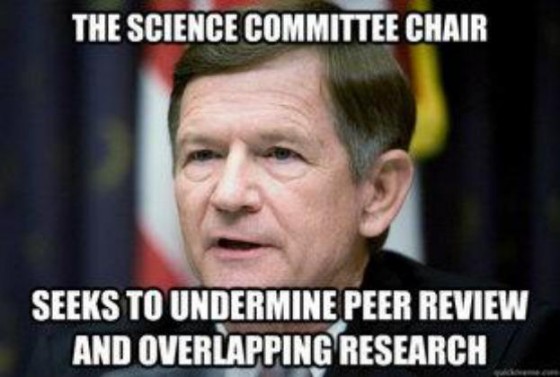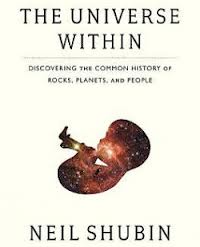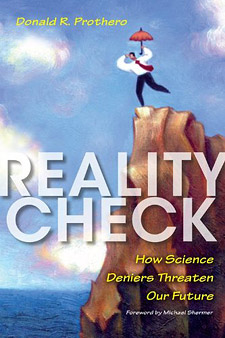by
Donald Prothero, Sep 06 2014
In recent months, we’ve heard a number of prominent people (from Michael Shermer to Neil DeGrasse Tyson) say that there’s no real difference between the political parties when it comes to science denial. According to this argument, there is bad thinking and “woo” on both sides of the political spectrum. To counteract the fact that science deniers like creationists and climate deniers are overwhelmingly Republican, they point to other types of “woo” like anti-vaxxers, anti-GMOs, anti-frackers, and the like, and claim that these are largely found on the left wing. It turns out, however, that contrary to myth, anti-vaxxers tend to be more right-wing than left-wing (especially among the people who fear government, the large religious crowd that rejects modern medicine, and the home schoolers who don’t want to let their kids be vaccinated).
For example, in his 2012 book The Republican Brain: The Science of Why they Deny Science—And Reality, Chris Mooney admits that not all examples of science denial are on the right wing. There are certain ideas, such as the fears of nuclear power, or of scary oil company practices like fracking, that are predominately held by liberals and environmentalists. But there are important differences here. Adherence to pseudoscience and anti-science is not symmetrically distributed between the left and the right. Ideas such as anti-vaxx, anti-nukes, and anti-fracking are not held uniformly by the majority of liberals or progressives, but only a tiny subset, whereas studies show that the ideas of creationism and global climate change denial are virtually universal among American conservatives now. Continue reading…
comments (15)
by
Donald Prothero, Aug 27 2014

In our modern world, we have a strange phenomenon. When polls are conducted about which professions the public considers most trustworthy and useful to society, scientists nearly always come out at or near the top. This poll by the Pew Research Center of 4006 American adults placed them just below the military, doctors, and teachers in terms of trust and their contribution to society. (To no one’s surprise, lawyers were considered the least trustworthy and contributed least to society). This poll by Ipsos of 1018 adults in the UK placed scientists just below doctors and teachers. (Lawyers were not included, so bankers and politicians came out at the bottom in the UK).
Historically, this has long been true. Most people appreciate the huge benefit that science brings to society in terms of the technological advances that make our lives longer and better. And despite the stereotypes, apparently most people still regard scientists as objectively seeking the truth, working hard in their labs, and trying to unravel the secrets of the universe. Unfortunately, the most common stereotypical myth, Hollywood’s “mad scientist out to destroy/ dominate the world” is still pervasive as well. Continue reading…
comments (43)
by
Donald Prothero, Jul 30 2014

Neil deGrasse Tyson on “Real Time with Bill Maher”, July 25, 2014
In a previous post, I commented on how the Religious Right got upset when “Cosmos” aired last spring. They were angry when “Cosmos” mentioned Giordano Bruno or scientists who were persecuted by religious extremists during their pursuit of truth. They recoiled in horror at how often “Cosmos” reminded us of our cosmic insignificance compared to the scale of the universe, or from the perspective of geologic time. They raged about the fact that “Cosmos” spent an entire episode on on evolution, and the topic of evolution came up repeatedly. And lots of pro-business types hated the episode about Clair Patterson’s lonely fight against the lead manufacturers, who were invisibly polluting the world and poisoning us all. The climate deniers hated that “Cosmos” mentioned anthropogenic global warming many times.
Nonetheless, most of the reviews for “Cosmos” were overwhelmingly positive and there’s good reason to think that it reached much of its target audience, and inspired a lot of people to think about scientific questions in a way that hasn’t happened since the original Sagan version of “Cosmos.” I have been rejoicing at the recent resurgence in the media popularity of science and evolution lately, especially after Bill Nye’s defeat of Ken Ham, the great response to Neil Shubin’s PBS documentary “Your Inner Fish,” and of course, the huge popularity of Neil DeGrasse Tyson and “Cosmos”. Finally, we have several major scientists (Nye, Tyson, Shubin) who are popular in the media, especially on trendy shows like “The Daily Show” and “Colbert Report” as well as national news networks like MSNBC and CNN. They are national celebrities for all the right reasons (smart, articulate, telling people the truth about science and the world), rather than being famous because of reality TV or sports or entertainment. They are becoming widely known, and doing a great job of promoting science against the tidal wave of junk science and pseudoscience in the media. There hasn’t been such high-profile popularity of scientists since the days of Sagan himself. It’s about time! Continue reading…
comments (32)
by
Donald Prothero, Feb 26 2014

One of the recurring themes at the Feb. 4 debate between Bill Nye and Ken Ham was Ham’s continuously harping on a supposed distinction between “observational science” (science we can observe in real time) and “historical science” (science that must be inferred from the past). This strange distinction is almost unique to Ken Ham, although I’m sure he borrowed from older creationist writings somewhere, since I remember reading about it when I researched creationism in the 1980s. Nevertheless, Ham kept pounding on it again and again, refusing to talk about any scientific evidence that couldn’t be witnessed in real time.
As many scientists have discussed, this distinction is complete bunk, and only Ken Ham and his followers seem to think that it makes any sense. Naturally, he pounds on this phony, self-serving, artificial distinction because it plays in his favor. Each time Bill pressed him on one point or another, Ham retreated behind his dodge of no one can know anything of “historical” past, then made the ridiculous assertion that the only reliable source of information about the past is the Bible. (Bill was too much of a gentleman to challenge him on this and ask Ken how he knows this. As Ham always says, “Were you there?”). Most of science tells us that the earth is old, that life has evolved, and so on. Ham wants to throw all this information away, so he creates a convenient but ridiculous distinction that serves his purposes—but bears no relation to what real scientists do or think. Continue reading…
comments (16)
by
Donald Prothero, Oct 09 2013

What did Adam and Eve never have, yet they gave two of them to each of their children?
Answer: parents
—Old children’s riddle
A classic example of an untestable theory to explain nature was the “Omphalos” hypothesis of Philip Henry Gosse. He was a well-respected naturalist in early nineteenth-century England who had written best-selling books about natural history. He was also a very devout member of a Puritanical sect called the Plymouth Brethren. As a good naturalist, Gosse was finding more and more evidence that life had evolved (long before Darwin), but as a Biblical literalist, he felt obligated to follow creationism. Gosse resolved his problems by publishing Omphalos: An Attempt to Untie the Geological Knot in 1857, just two years before Darwin’s book was published. The curious title omphalos means “bellybutton” or “navel” in Greek, and refers to the common theological conundrum of the day: if Adam and Eve were specially created and did not have human parents (and therefore no umbilical cord), did they have a navel or bellybutton? Many religious artists avoided this issue by painting Adam and Eve with a fig leaf not only over their genitalia, but also over their midriffs. Gosse’s answer was yes, of course Adam and Eve had navels. According to Gosse, God created nature to look as if it had a history, to look as if it had evolved, but in reality it was created quite recently. In order for the world to be “functional” God would have created the earth with mountains and canyons, with trees that have growth rings, and with Adam and Eve with a navel. No evidence that indicates the presumed age of the earth or events in the past can be taken at face value. In this manner, Gosse felt that he had solved his own dilemmas about the fact that nature appears to have evolved, yet this solution allowed him to retain his creationist beliefs.
Continue reading…
comments (33)
by
Donald Prothero, May 22 2013

The saddest aspect of life right now is that science gathers knowledge faster than society gathers wisdom
—Isaac Asimov
A few weeks ago, we heard in the news the chilling and alarming statement that Rep. Lamar Smith (R-TX), chair of the House Science and Technology Committee, wants to subject all the scientific research grants of the National Science Foundation (NSF) to political scrutiny. No longer was it sufficient that the NSF conduct peer review of grants by experts in the field to determine whether they are worthy of funding. No, the House Committee has decided that they are better judges of good science that the scientific community itself, and they ought to be able to override the decisions of scientists who work in the field.
We’ve seen this kind of political interference in science before, but never at such a high level. Even more disturbing, the GOP members of the House Science and Technology Committee are not the kind of people that most of us would want judging the quality of science. They are nearly all science deniers of one sort or another. This committee includes such luminaries as Rep. Paul Broun of Georgia (an M.D., even!), who said (in a recent speech at the Liberty Baptist Church Sportsman’s Banquet):
“God’s word is true. I’ve come to understand that. All that stuff I was taught about evolution, embryology, Big Bang theory, all that is lies straight from the pit of hell. It’s lies to try to keep me and all the folks who are taught that from understanding that they need a savior. There’s a lot of scientific data that I found out as a scientist [note: Broun is NOT a real scientist] that actually show that this is really a young Earth. I believe that the Earth is about 9,000 years old. I believe that it was created in six days as we know them. That’s what the Bible says. And what I’ve come to learn is that it’s the manufacturer’s handbook, is what I call it. It teaches us how to run our lives individually. How to run our families, how to run our churches. But it teaches us how to run all our public policy and everything in society. And that’s the reason, as your congressman, I hold the Holy Bible as being the major directions to me of how I vote in Washington, D.C., and I’ll continue to do that.”
Continue reading…
comments (73)
by
Donald Prothero, May 01 2013

A review of The Universe Within: Discovering the Common History of Rocks, Planets, and People, by Neil Shubin (Pantheon, New York, 2013).
Popularizing science, and writing science trade books for general audiences, is a challenging business. As an author of trade science books myself, I know how hard it is to write a book that sells well. Many of my fellow scientist-writers complain that the trade science book market is vanishing as fewer and fewer people read much any more, and those who do read a lot don’t read non-fiction/science. Only a handful of scientists (Carl Sagan, Isaac Asimov, Stephen Jay Gould, Richard Dawkins, and just a few others) have managed to do it well for a long time. They are among the few that have reached the best-seller lists and achieved celebrity status so they are recognizable names and faces (and some have even appeared on The Simpsons, the ultimate arbiter of pop-culture status). Some of these people (especially Sagan) were attacked and scorned by their scientific peers for being “too popular” and no longer serious about their science, even though studies have shown that Sagan and Gould and the others were just as productive in their peer-reviewed science even as they reached superstar status. On the other hand, many people have cried out for the scientific community to provide us with more Sagans and Goulds who can make science interesting and comprehensible to a public that is becoming increasingly ignorant of science, or sucked into pseudoscience of UFOs and Bigfoot, or the junk science of creationists, anti-vaxxers, and climate change deniers. Continue reading…
comments (2)
by
Donald Prothero, Apr 03 2013

The workshop was held at NESCent, with modern facilities built inside classic old brick buildings on the Duke campus that used to be warehouses
On the weekend of March 22-24, 2013, I was privileged to be part of an amazing workshop entitled “Reporting across the culture wars: engaging media on evolution.” Hosted by the NSF-sponsored think tank, the National Evolutionary Synthesis Center (NESCent) on the Duke University campus in Durham, North Carolina, it brought together some of the top names in both science and journalism, all experienced in the battle over evolution and creationism. It was organized and moderated by Lauri Lebo, the local reporter at the 2005 Dover, Pennsylvania, “Intelligent Design” trial who wrote a best-selling book, The Devil in Dover, about her experience, and by molecular biologist Dr. Norman Johnson of University of Massachusetts Amherst. These two organizers raised the funds to bring in a very diverse panel of experts, including Dr. Ken Miller of Brown University, one of the leading biologists battling creationism (he was the star of the Dover trial, and has beaten creationists in debates many times); Josh Rosenau of the National Center for Science Education (NCSE), who handles their efforts to support citizens fighting creationism in their schools; several authors of books about evolution and creationism, including yours truly, plus Dr. Michael Berkman of Penn State, Dr. David Long of George Mason University, and Dr. Daniel Fairbanks of Utah Valley University; a distinguished group of biologists, including Dr. T. Ryan Gregory of Guelph University, Dr. Melissa Wilson Sayres of UC Berkeley, Dr. Craig McLain of NESCent, and Dr. David Hillis of the Univ. Texas Austin; anthropologists, including Dr. Holly Dunsworth of Univ. Rhode Island, Dr. David Long, and Dr. Briana Pobiner of the Smithsonian; and paleontologists including myself and Brian Switek of the Laelaps blog on Smithsonian.com. Among the journalists were Greg Bowers of the Univ. Missouri Journalism school, Lou DuBose of the Washington Spectator, Kate Sheppard of Mother Jones, as well as e-journalists such as Cara Santa Maria, the science editor of The Huffington Post (her regular podcast, “Talk Nerdy to Me”, is a big hit on HuffPo), and Danielle Lee and Bora Zivkovic of the Scientific American blog. In addition, there were local Public Information Officers (PIOs), who handle press relations for scientists, including Dr. Robin Smith of NESCent and Karl Bates of Duke University. In short, this panel brought both a lot of experience and a lot of brainpower to the discussion, with a panel ranging from freelance print journalists to e-journalists to science writers to distinguished scientists in biology, anthropology, and paleontology—and nearly everyone on the panel has their own blog.
Continue reading…
comments (7)
by
Brian Dunning, Mar 14 2013
 STEM = Science, Technology, Engineering, and Mathematics.
STEM = Science, Technology, Engineering, and Mathematics.
The STEM fields are of special significance in the United States, as they are considered by the government to be strategically important, and because we have a shortage of experts in these fields. As a result, many government and educational agencies have STEM programs, and we’ll discuss some of those in a moment.
My purpose today is to nip a growing trend in the bud, which is the tendency for people involved in the arts to expand it to STEAM (A = Arts). Nearly everyone in my family (except me) is musical, and so I sit through a lot of fundraising presentations at concert halls, always hearing the pitch of why STEAM fields are so important. It’s in the high school newsletters, it’s in the local performing arts community brochures; it’s everywhere you look when you go to an art show. Continue reading…
comments (157)
by
Donald Prothero, Jan 02 2013

Buried in all the news of the end of the world, the “fiscal cliff”, and the holiday season was another item that probably escaped most people’s attention. The Field Museum of Natural History in Chicago, one of the world’s foremost natural history museums, is planning huge cutbacks in their scientific staff in the next few weeks. Details of who will be cut are sketchy, but the news raced through my professional community and made us all very upset. This is not only because many people who are our personal friends will be losing their jobs because of mismanagement at the top, but also because such a disastrous move would hurt science in many ways that the general public may not appreciate.
First, some background. The Field Museum was founded in 1893 after the Chicago’s Columbian Exhibition of that year ended, and named because of a large endowment from retail mogul Marshall Field (whose stores were a landmark in Chicago until bought out by Macy’s in 2005). It is one of the world’s largest natural history museums, with not only spectacular exhibit halls of dinosaurs and modern animals and gems and minerals and everything else (such as the famous “Lions of Tsavo” and “Tyrannosaurus Sue”), but even larger research collections—almost 400,000 fossil specimens alone! It seemed that such a longstanding landmark would never have trouble, but those of us who have worked in private museums know they are always scrambling for a buck to match their costs, and they are constantly staging fundraisers and schmoozing rich donors with gala events to keep the money coming. A few years ago they seemed to be on top of the world with the coup of acquiring (thanks to huge donations from McDonalds, Disney, and other corporations, not their own money) the famous tyrannosaur “Sue” (now featured in their main hall). But their CEO and trustees apparently made some risky investments, and gambled their endowment on financial instruments that got clobbered in the recession, and now they’re hurting for money. Thanks to the bad decisions of investors, everyone else will suffer (shades of the financial meltdown of 2008). They’ve already cut a lot of other expenses to the bone, fired a lot of the less-skilled support staff, and canceled expensive traveling exhibits. Now they’re about to cut their own hearts out and destroy the staff that makes the museum run in the first place.
Continue reading…
comments (27)









 STEM = Science, Technology, Engineering, and Mathematics.
STEM = Science, Technology, Engineering, and Mathematics.